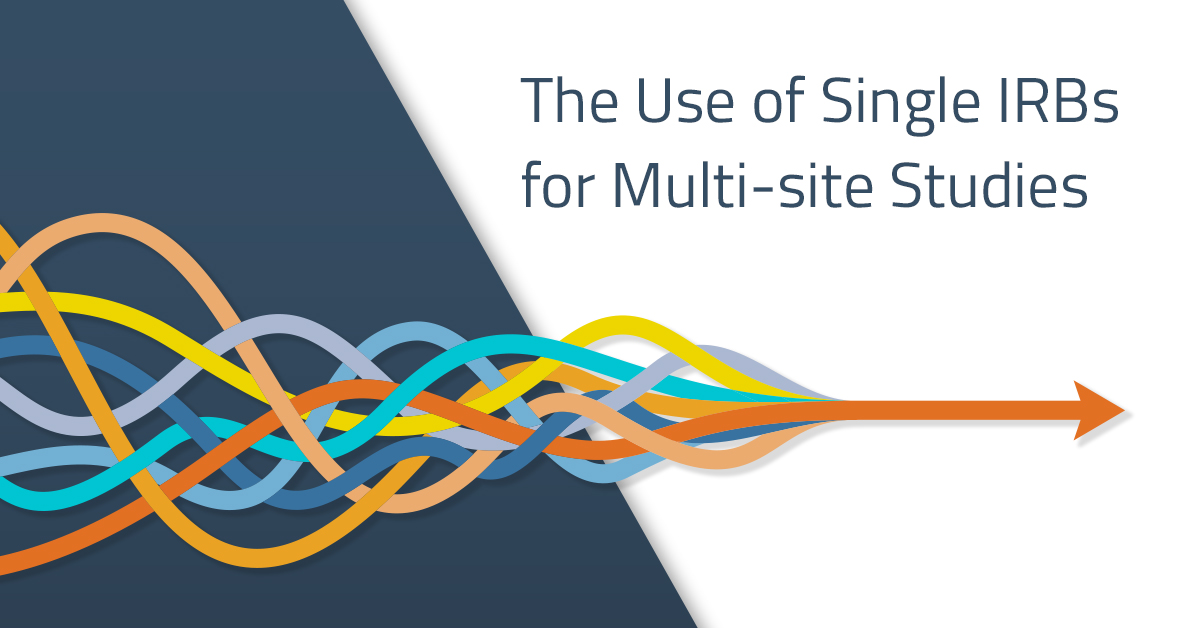
The Use of Single IRBs for Multi-Site Studies
Authors:
Frank McAneny, MS, MBA, CCRP, CHRC, CCEP, CSSGB – Director of Research Compliance
Sarah Ziegler, Ph.D., SM(NRCM), RBP, CBSP – VP of Research Compliance
The Single Institutional Review Board (sIRB) ruling, mandated by the National Institutes of Health (NIH) and the revised Common Rule, represents a significant change in the oversight of multi-site clinical trials. The anticipated ruling by the Food and Drug Administration (FDA) on using sIRBs is a substantial step forward in streamlining the ethical review process for multi-site research studies and aligns with previous mandates from NIH regarding multi-site studies in the United States. The FDA and NIH rulings aim to reduce redundant reviews, enhance consistency, and speed up the initiation of clinical trials by having one IRB review and approval for research protocols for all participating sites.
Historic IRB Models
The historical or traditional model of IRB review involved each participating site in a multi-site study conducting its own IRB review. This often led to delays, increased administrative burdens, and inconsistencies in ethical oversight. Each site’s IRB could have different requirements and timelines, resulting in a fragmented review process that slowed down study initiation and created variability in protecting research participants. These inefficiencies often impeded the start-up of clinical research and hindered the management of multi-site trials.
To address these issues, the NIH introduced the sIRB policy in 2016, mandating the use of a sIRB for multi-site studies funded by the NIH. This policy aimed to streamline the IRB review process by designating one IRB to oversee the full trial, reducing redundant reviews, and harmonizing decisions across sites. The revised Common Rule, implemented in 2018, further reinforced the sIRB mandate by extending its applicability to most federally funded research. The FDA released a proposed rule change in September 2022, expected to be finalized in 2024 and align with NIH mandates.
The primary objectives of the sIRB ruling are to:
- Enhance the efficiency of IRB reviews for multi-site studies.
- Reduce administrative burden and delays.
- Ensure consistent application of ethical standards across all sites.
Regulatory Framework
NIH sIRB Policy
Effective January 25, 2018, the NIH policy mandates that all domestic sites participating in NIH-funded multi-site studies must use a sIRB to review human subjects research ethically. Exceptions are allowed only in specific circumstances, such as when federal, tribal, or state laws require local IRB review.
Revised Common Rule
The revised Common Rule, which took effect on January 21, 2019, aligns with the NIH sIRB policy and extends the requirement to all multi-site studies funded by other federal agencies. It includes provisions for cooperative research, emphasizing using a single IRB to reduce duplication of effort.
Proposed FDA Rule
On September 28, 2022, the FDA released proposed language for a new rule requiring FDA-regulated cooperative research within the U.S. to rely on review and approval by a sIRB. This would align with NIH requirements and the Revised Common Rule. Finalization of this rule is expected in 2024.
Current sIRB Enforcement
The NIH and the Office for Human Research Protections (OHRP) oversees compliance with the sIRB ruling. Enforcement mechanisms include grant and contract terms that require adherence to the sIRB policy, periodic audits and inspections by NIH and OHRP, and mandatory reporting of compliance issues by institutions. Once the FDA rule is finalized, the FDA will also enforce the requirement for sIRBs.
Institutions involved in multi-site research must identify a sIRB for ethical review, establish reliance agreements with a sIRB, and ensure that all sites adhere to the sIRB’s determinations. Investigators must coordinate with the chosen sIRB for all required submissions and communications and ensure the sIRB addresses all site-specific requirements and local context issues. All sites must report any issues or non-compliance to the sIRB promptly.
Benefits of Using sIRB and Centralized IRBs
The widespread adoption of sIRBs is expected to significantly improve the efficiency of the oversight process, reduce administrative burdens, and facilitate quicker start-up and execution of clinical trials. By centralizing the review process, the sIRB model reduces the time required for IRB approval, leading to faster study initiation and shortening the overall timeline for research projects. This acceleration is particularly crucial in clinical trials where timely progression can impact patient outcomes and the availability of new treatments.
Moreover, a sIRB ensures that ethical standards are applied uniformly across all sites, reducing variability and enhancing the protection of human subjects. Consistent ethical oversight across multiple sites minimizes mistakes that could otherwise compromise the study’s integrity and the participants’ safety. This uniformity is important in maintaining high ethical standards and public trust in research. Centralized IRB review also minimizes administrative tasks for investigators and IRB staff. This reduction in administrative workload means that researchers can focus more on their studies’ scientific and operational aspects, potentially increasing the quality and impact of their research.
Challenges and Concerns for the sIRB Model
Effective communication and coordination among participating sites and the sIRB are crucial. Differences in institutional policies and procedures can complicate this process. Ensuring compliance with various federal, state, and local regulations can be challenging, mainly when dealing with diverse institutional requirements. While the sIRB model aims to reduce the administrative burden, it can increase costs for the lead institution responsible for coordinating the sIRB review. Training investigators and staff on the new sIRB processes and requirements is essential to ensure smooth implementation and compliance.
Conclusions
The sIRB ruling represents a new approach to ethical review in multi-site clinical trials. By centralizing IRB oversight, the NIH and FDA ruling aims to enhance efficiency, consistency, and collaboration while reducing administrative burden. However, successful implementation requires careful planning, effective communication, and ongoing evaluation. As institutions adapt to this new model, the potential for more streamlined and effective research oversight is significant, benefiting researchers and participants alike. This ruling is poised to help researchers, institutions, and, most importantly, the participants involved in clinical research.
Explore how Sitero’s comprehensive IRB services can support your institution in seamlessly transitioning to this new model, ensuring efficient and consistent ethical review across all your multi-site clinical trials. Contact us today to learn more about our tailored solutions and expert guidance.
References
- National Institutes of Health (NIH). (2016). Final NIH Policy on the Use of a Single Institutional Review Board for Multi-Site Research. Retrieved from NIH website.
- U.S. Department of Health and Human Services (HHS). (2018). Federal Policy for the Protection of Human Subjects (‘Common Rule’). Retrieved from HHS website.
- National Institutes of Health (NIH). (2018). Revised Common Rule and Single IRB Requirements. Retrieved from NIH website.
- U.S. Department of Health and Human Services (HHS). (2019). Revised Common Rule. Retrieved from HHS website.
The future of clinical trials is a unified, interoperable ecosystem. Sitero’s Mentor platform is leading this transformation, ensuring that clinical trials are more efficient, compliant, and streamlined than ever before. Learn more in our latest blog:
Today’s trials require data entry from anyone, anywhere including patients, sites, home nurses, and remote investigators. Learn why EDC systems must evolve to support decentralized trails in our latest blog:




